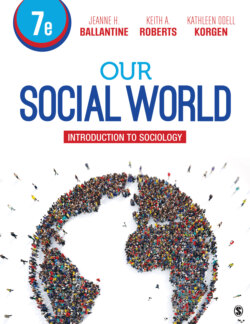Читать книгу Our Social World - Kathleen Odell Korgen - Страница 117
Postindustrial or Information Societies.
ОглавлениеPostindustrial societies are those that have moved from human labor and manufacturing to automated production and service jobs, largely processing information. Postindustrial societies require workers with high levels of technical and professional education. Those without technical education are less likely to find rewarding employment in the technological revolution. This results in new class lines being drawn, based in part on skills and education in new technologies, and can influence political participation and voting preferences, attitudes toward technology, and other factors of modern life.
The shift to an information-based society has also enhanced cross-border workplaces. As your authors finished chapters for this book, they were sent to India for typesetting in the evening; due to the time change with India being 9 hours and 30 minutes ahead of the U.S. East Coast, chapters were returned to the United States by the next morning. Technology, the efficiency of overnight delivery, and the lower cost of production have led many publishing companies to turn to businesses halfway around the world for much of the book production process. As India and other developing countries increase their trained, skilled labor force, they are being called on by national and multinational companies to carry out global manufacturing processes. India has some of the world’s best technical training institutes and modern technology—the practical application of tools, skills, and knowledge to meet human needs and extend human abilities. Although many people in India live in poverty, a relatively new middle class is rapidly emerging in major business centers around the country.
▲ This Buddhist monk uses modern technology, including a laptop that can connect him with colleagues on the other side of the globe.
© Reuters/Mike Segar
After World War II, starting in the 1950s, the transition from industrial to postindustrial society began in the United States, Western Europe, and Japan. This shift was characterized by movement from human labor to automated production and from a predominance of manufacturing jobs to a growth in service jobs, such as computer operators, bankers, scientists, teachers, public relations workers, stockbrokers, and salespeople. More than two thirds of all jobs in the United States now reside in organizations that produce and transmit information, thus the reference to an information age. Daniel Bell describes this transformation of work, information, and communication as the third technological revolution after industrialization based on steam (the first technological revolution) and the invention of electricity (the second technological revolution) (Bell 1973). According to Bell, the third technological revolution was the development of the computer, which has led to this postindustrial era or information age. To examine this transformation, see Table 3.2 in the Engaging Sociology feature on the opposite page.
Engaging Sociology
Demographics of Internet Users
The following is the percentage of each group of U.S. adults who use the Internet, according to the Pew Internet/Broadband Fact Sheet. For instance, 88% of women and 89% of men use the Internet.
▼ Table 3.2
Source: The Pew Research Center’s Internet/Broadband Fact Sheet 2018.
Note: Surveys conducted 2000–2018. Data for each year based on a pooled analysis of all surveys conducted during that year. Data for Hispanics includes only surveys that included Spanish-language interviews.
